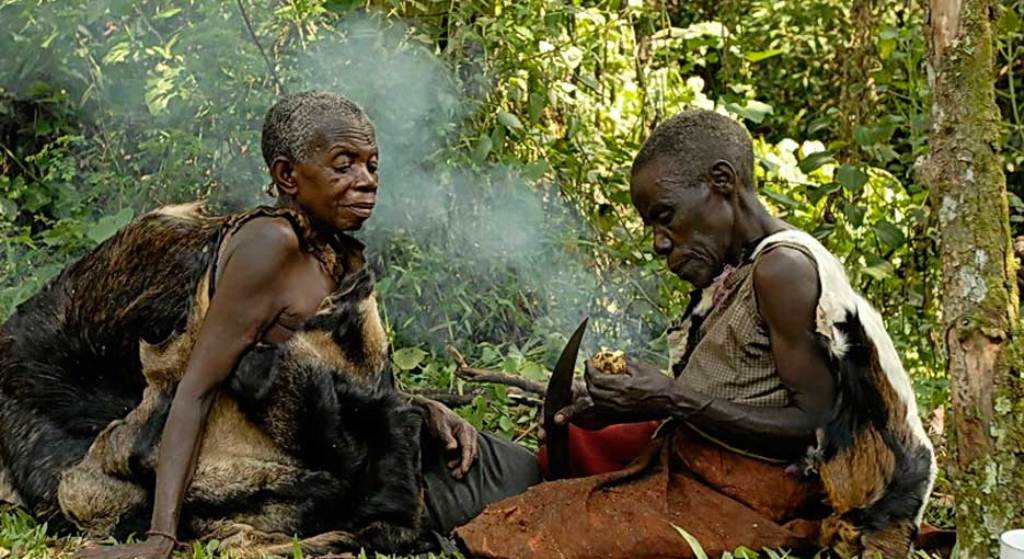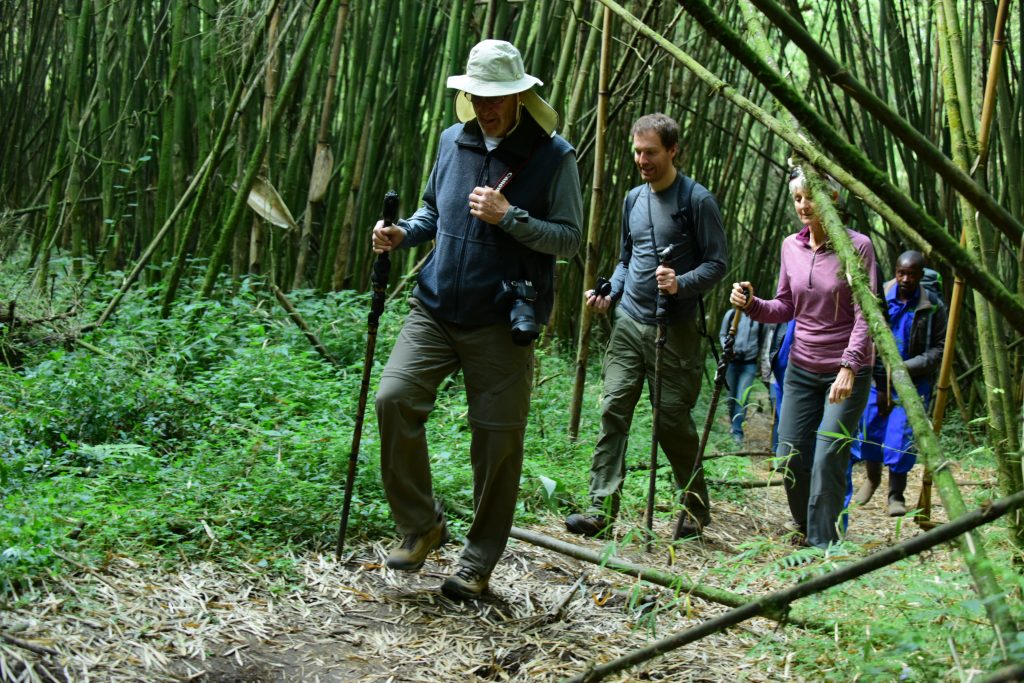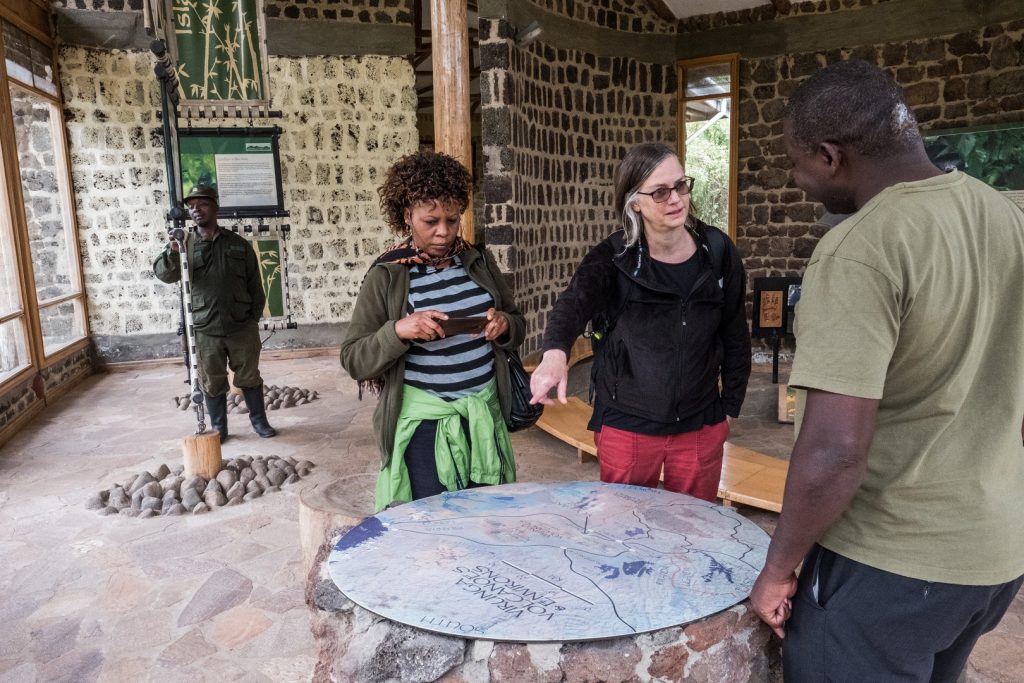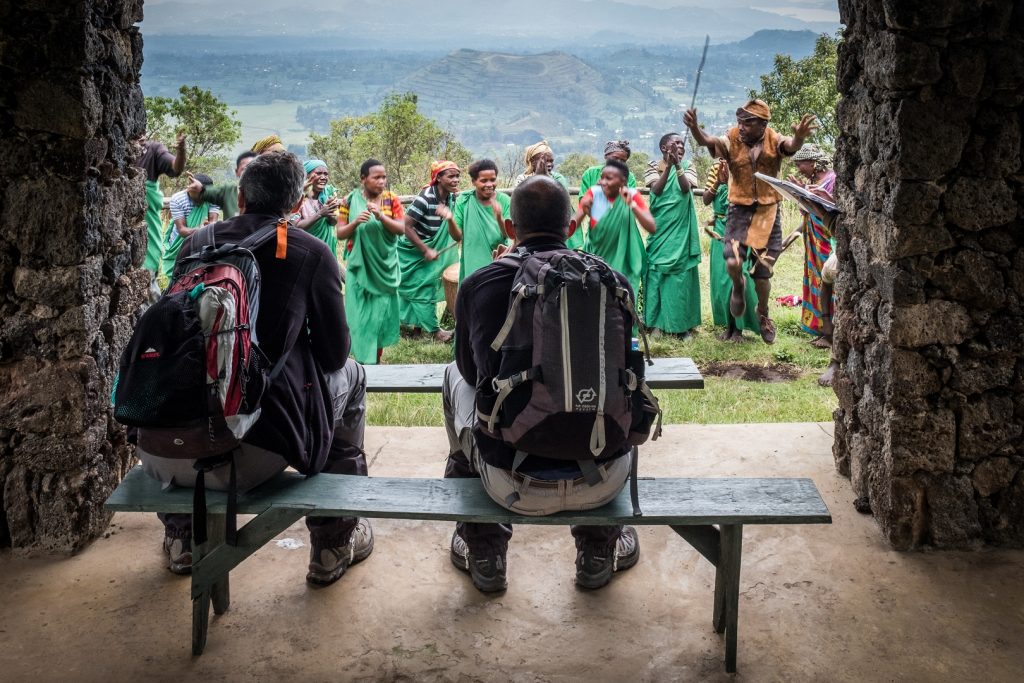
The Batwa trail is located in Mgahinga Gorilla National Park, on the slopes of the Virunga Volcanoes in South Western Uganda. The Park lies 520km from Kampala and 10km south of Kisoro. The first 430km to Kabale are on good tarmac. The 80km stretch to Kisoro follows a winding mountain road which is presently marram but is in the process of being surfaced. The Batwa Trail runs across the lower slopes of the Muhavura and Gahinga Volcanoes in Mgahinga Gorilla Safari Park.
The forest is home to a variety of wildlife but the Batwa Trail is far from being a conventional nature walk. With the help of Batwa guides, you will see the forest as a larder, pharmacy, builder’s yard, tool kit and above all, a home. Along the Trail, you will fire a bow and arrow, check hives for wild honey, help repair a Batwa shelter, harvest plants for medicine and food, light a fire without matches, listen to legends and learn about Batwa traditions. Book Now
Starting the Batwa Trail Experience
The highlight of the trail is a descent into the Garama cave, a 200m long lava tube beneath Mt. Gahinga. The Batwa are famed for their music and dance and their historic, subterranean council chamber in Garama cave provides the setting for an unforgettable performance. The Batwa trail is a celebration of the forest culture of the ‘first people’. It is impossible, however, to ignore the fact that Batwa life has greatly changed. The day’s events conclude is a discussion about the Batwa’s current situation; how it can be improved; and progress towards doing so.

Mgahinga National Park is home to a fantastic diversity of flora and fauna, including some exotic plants and rare and endangered animals. The forest was also home to the Batwa pygmies. These indigenous people were the original dwellers of the ancient forest and were known as the ‘keepers of the forest’. The Batwa lived in harmony with the forest and survived by hunting small game using bows and arrows and gathering plants for both food and medicinal purposes.
A day spent with the Batwa gives you the opportunity to enjoy the hiking in the forest with the people of the forest. You will have a Batwa guide and he will provide you with the chance to see the forest and its habitants through their eyes as you see how they lived and hunted in the traditional manner and enjoy trying out your hunting techniques as the Batwa teach you how to shoot with a bow and arrow. Visit a traditional Batwa homestead and learn from the women how to prepare, cook and serve a meal. You will also have the opportunity it sample the dishes, talk to a medicine men and learn about the medicinal properties of the forest flora as well hearing ancient legends and traditional songs.
Book NowOrigin of the Batwa People
Walking the forest on the foot of Muhavura, Sabinyo and Gahinga volcanoes, with middle aged Batwa as guides, the exciting event begins with a briefing about the origin of the people around the three extinct volcanoes. George Mpagazehe, clad in culturally designed animal skin portraying their old style of dress, tells of the history of an old man called Gihanga, meaning Creator, and his three sons: Gatwa, Gatutsi and Gahutu, whom he entrusted with full milk gourds to see how they would utilize their talents. Mpagazehe says Gatwa consumed all his milk and was given hunting tools and a forest to become a hunter.

Gatutsi retained all his milk and was bequeathed with herds of cattle to become a herdsman, while Gahutu drank half of his milk and was given a hoe to become a farmer. He explains that this was the genesis of the Batwa, otherwise known as pygmies or forest people, ending up as nomadic hunter-gatherers living in the forests before they gave up this way of life when Mgahinga and Bwindi forests were gazetted as national parks. The Batwa, who currently live on the edge of the forests, are organized under the United Organization for Batwa Development in Uganda (UOBDU). They boast of trained guides that take the visitors through their former hunting grounds, worship places, council chambers and dwelling huts.
At the start of the trail, guides and visitors bow to pray to Biheko, their cultural god, for blessing and protection so that they come out of the forest safe and with reasonable harvest – including meat from hunting. The guides also take visitors through the medicinal values of various herbs, honey collection from sting and non-sting bees, and the Batwa traditional huts and accompanying shrines. Visitors also see the tree branches where the Batwa used to leave their children shielded from forest animals during their errands, water collection using bamboo tubes, trapping of small and big animals, and sacrifices to their gods in appreciation for their successful hunting expeditions.
Book NowLifestyle of the Batwa People
Following the Batwa trail, guides are not timid about narrating how they used to raid for food from neighboring communities’ gardens and would either fight those pursuing them or hide in the Garama cave – a lava tube that is a result of volcanic action on the basement of Gahinga Mountain. The climax of the trail is the rock cave, about 200 metres long, characterized by compartments where different activities took place. The guides say the cave acted as the Batwa king’s palace (Ulutale), where he would issue out laws and be entertained.
The cave a long the Batwa trail also served as a store for food, was a hideout for the Batwa after raiding neighboring communities for various items, especially food. It was also a training ground for the youth in fighting skills, as well as a meeting place for clan elders. The descent into the cave on slippery rocks into a semi dark enclosure is as exciting as it is scary. But, this temporary nervousness is mitigated by rhythmic tunes from different directions, as Batwa cultural dancers emerge from different directions welcoming visitors to the sacred cave, before the lights from grass torches are lit to enable the spectators enjoy the drama.
The Batwa trail ends with thrilling traditional performances by Batwa women, men and children, displaying their dancing strokes, accompanied by music depicting how they used to live and their plight today. In 1991, the Batwa in Uganda were evicted from the forests they had lived on since time immemorial. As a result, most were left landless and impoverished and, to survive, resorted to begging and life as laborers on other people’s land.

As in the legend, originally the Batwa were forest dwelling hunter-gatherers, living and practicing their cultural and economic way of life in the high mountainous forest areas around Lake Kivu in Rwanda and Lake Edward in the Great Lakes region of Central Africa; today, the Batwa way of life, their cultural, spiritual, and social traditions, are at risk.
The Batwa are widely accepted as the first inhabitants of the region, later joined by farmers and pastoralists. The Batwa are still to be found living in Rwanda, Burundi, Uganda and eastern Democratic Republic of Congo, with an estimated total population of 86,000 to 112,000.
Book NowAs their traditional forested territories were destroyed by agriculturalists and pastoralists or gazetted as nature conservation areas, the Batwa were forced to abandon their traditional lifestyle based on hunting and gathering. The Batwa, sometimes derisively to as Pygmies, became squatters living on the edges of society; some were able to develop new means of survival as potters, dancers and entertainers.
Traditionally, the Batwa had three main types of houses: caves, omuririmbo and ichuro. The caves and omuririmbo were the main houses where Batwa lived. Ichuro was used for resting and storing food including meat, honey, beans and sorghum, all of which in makeshift grass thatched round huts that can accommodate about five people at a time.
The Batwa also had a special way of burying the dead. When a Mutwa died, he or she would be buried in a hut after digging a small hole and wrapping the corpse in grass. The burial ceremony involved cleansing the corpse with herbs such as omuhanga (Maesa lanceolata), enkyerere (Rubus sp.), and omufumba (Rhumex sp).
The Batwa elders would lead the burial ceremony and encourage all the family members to drink herbal extracts as a way of preventing death from claiming more people from that family. After burial, they would migrate to a far off place and never return.
According to Batwa customs, a Mutwa cannot marry a non-Mutwa and getting pregnant before marriage was forbidden. Marriage was arranged by the parents. The parents of a Mutwa boy would admire qualities in a certain Mutwa girl and decide that she was the right partner for their son. They would then visit the girl’s family carrying gifts which included pots of honey from stingless bees, beer brewed with honey and roast meat.
During the visit, they would negotiate the dowry to be paid to the girl’s family and the date for the ‘give-away’ ceremony. On the day of ‘giving away’ the girl, the groom would bring many gifts for the bride and her family. Such gifts included beads, new and well-oiled animal skins, roast meat, elephant tusks, honey from stingless bees, beer brewed with honey and sometimes hunting dogs.
The groom would take the bride to his home and then live together while receiving advice from the groom’s parents. After some time, the young family would later migrate to a distant place to establish their new and independent home. When the woman became pregnant, she would be fed on meat, honey and vegetables and would drink many kinds of herbs for boosting her health and that of the unborn baby.
At the time of giving birth, she would be helped by other women who would use pieces of bamboo to cut the umbilical cord. The baby would be wrapped in clean animal skins and brought near a fire place for warmth. This way of living is under threat or has already vanished.
Threats to Batwa Community
For three decades, the Batwa have been struggling to have their rights recognized. The legal case is unlikely to succeed, so the Batwa remain stuck in a legal limbo with unpromising prospects.
Dawn cracked over in 1992, the lives of the Batwa changed forever, when the forest became a national park and world heritage site in order to protect the endangered mountain gorillas that reside within its boundaries. The Batwa were evicted from the park and became conservation refugees in a world that was very unfamiliar to them. Their skills and means of subsistence were not useful in this modern environment and they began to suffer.
In 2001, when the Batwa tribe was on the edge of extinction American medical missionaries, Dr Scott and Carol Kellermanns came to their rescue. They purchased land and established programs to improve the conditions and lives of the Batwa. This included the building of a school, hospital and housing. The Kellermanns also developed water and sanitation projects and found ways that the Batwa could generate income and sustain themselves.
These projects are now managed and operated by the Batwa Development Program (BDP). BDP works closely with the Batwa community to try to ensure that their indigenous rights are respected and they also benefit from the forest being a national park and tourist attraction The social status of the Batwa In last census of 2002, the Batwa population in Uganda is about 6000, with the majority living in the Southwestern districts of Kabale, Kisoro, Kanungu, Bundibugyo and Rukungiri.
The size of the Batwa is quite different from other tribes in Uganda, the men and women rise to an average of four feet or less in height, the tallest man among the Batwa would be the shortest among the neighboring community, the Bakiga. Traditionally, the Batwa lived as hunters and gatherers, residing in temporary huts and caves, deriving sustenance from forest resources like honey, wild fruits, mushrooms and vegetables. Each clan collectively owned an area of forest within which they derived food and herbal medicine for their sustenance.
After undertaken the study in 1996, the Batwa reside in about 53 separate settlements falling within 41 villages. On average each settlement is composed of about 10 households. The household sizes range from single to 17 member households. Despite living in different settlements, the Batwa have strong social relations and recognize themselves as a community. They share close attachments to certain areas within concomitant social formations that appear to derive directly from the ancient past. Marriages normally take place within the clans though marriage among members of an individual settlement is rare because of the close relations amongst such persons. Batwa still practice social norms and customs normally associated with clanship similar to majority of other tribes in East and Central Africa. However, due to the resettlement programme most Batwa are never sure of their clan leader and where he lives.
The Batwa Pygmies are believed to be the original inhabitants of the equatorial forests of the Great Lakes region of Central Africa. The forest was their home. It provided them with sustenance and medicines, and contained their sacred sites. Their low-impact use of forest resources meant that their way of life was sustainable over thousands of years.
The New Lifestyle of the Batwa Community
The dense forests at the foot of the Virunga Volcanoes were home to the Batwa people: hunter-gatherers and fierce warriors who depended on the forest for shelter, food and medicine thanks to ancient knowledge passed down for generations. the Batwa were suddenly evicted from the forest and forced to abandon their low-impact, nomadic lifestyle.
Now landless, they work when they can for local farmers, and the only time they are permitted to re-enter their cherished forest is as tour guides on The Batwa Trail, where they invite visitors to discover the magic of their old home. During this moving tour, the Batwa demonstrate hunting techniques; gather honey; point out medicinal plants and demonstrate how to make bamboo cups. Guests are finally invited to the sacred Ngarama Cave, once home to the Batwa King, where the women of the community perform a sorrowful song which echoes eerily around the depths of the dark cave, and leaves guests with a striking and moving sense of the richness of this fading culture.
Traditional Economy of the Batwa-Bambuti‘s economy is just as simple as their general way of life. They are wanderers by nature with no fixed place of abode. Their chief means of subsistence is meat and the forests where they live abound with elephants, monkeys, lizards and some antelopes. The Bambuti prey on these animals and several others which the forest contains. As one would expect, the Batwa-Bambuti have no home industries. Their mode of life is purely subsistence and they do not seem t be troubled by lack of home comfort.
Crafts; Batwa communities living around the Mgahinga National Park and Bwindi Impenetrable National Park produce a variety of attractive handcrafts. These are sold to provide income to craftsmen and women, and to generate funds for UOBDU activities. The United Organization for Batwa Development in Uganda (UOBDU) promotes Batwa rights and helps to provide Land, education, and health care. UOBDU’s flagship activity is the newly established Batwa Trail. Run by UOBDU members, this is Uganda’s first organized tourism project. By participating in this new initiative, and sharing your experiences with others, you can help UOBDU to make a difference.
Book Now